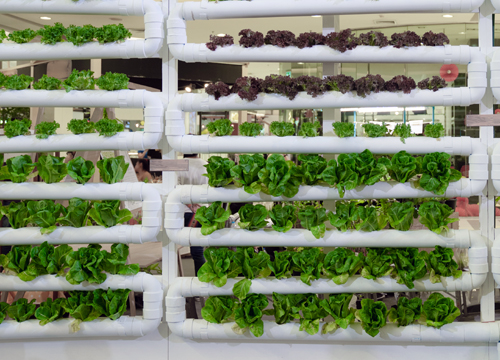Countries Plan for Food Provision Featured Signal of Change: SoC1218 March 2021

The agriculture and food industries have remained fairly unchanged by digital processes and many advanced technologies (aside from gene technology, which had a dramatic effect on agriculture). But these industries have become a target for start-ups, venture capital, and research. New technologies and approaches abound and have the potential to transform the agriculture and the food industries radically in the coming years; however, such transformation still requires bringing all the developments together and connecting the dots.
Government organizations are now taking a fresh look at food provision.
No shortage of new concepts and approaches exists, as recent Scan™ documents illustrate:
- P1590 — Technologies' Transforming Agriculture highlights that emerging technologies could prove vital to improving agricultural efficiency and ensuring the feeding of Earth's growing population.
- P1553 — A Fresh Approach discusses how governments and organizations are rethinking food supply chains to improve the availability of fresh food and reduce waste.
- SoC1175 — The Rise of Vertical Farming explains that commercial and environmental landscapes now offer market openings that providers of vertical farming can exploit.
- P1456 — Novel Food Proteins points out that various novel proteins for human consumption are attracting market attention.
- SoC1105 — Robotic Farming describes how the agriculture industry is increasingly making use of advanced robotics applications, which could lead to its undergoing structural changes.
Putting these developments in context and launching a coordinated effort to push agriculture and food technology in the twenty-first century are crucial to the agriculture and food industries.
Government organizations are now taking a fresh look at food provision and trying to understand—and drive—changes that could eventually secure the environmentally friendly growing and processing of healthful foods. In December 2020, the European Union published the Farmers of the Future report, which depicts the agricultural landscape in 2040 to outline challenges that the farming community will face in the coming years. The report takes into account a variety of factors, including technological changes, infrastructural considerations, climate change, and consumers' demand for food in light of changing dietary habits. To provide a comprehensive overview of future challenges and opportunities, the report's authors developed 12 farmer profiles that "reflect existing and emerging realities in European agriculture. A set of 14 megatrends that will affect farming in the two coming decades was applied to the profiles.... Together, as a group of farmers, they reflect the increasing diversity of agriculture and simultaneously, how similar megatrends will affect each of them differently" (Farmers of the Future, European Union, 16 December 2020; online). The authors of the report stress that their intent is not to provide forecasts but to investigate potential changes in the future of farming.
Several European countries outside the European Union are also developing strategies to ensure the long-term productivity of the agriculture and food industries. For example, Healthy Nutrition and Sustainable Food Production, one of the Swiss National Science Foundation's (Bern, Switzerland) National Research Programmes, recently recommended that the government of Switzerland create a strategy to ensure that the entire Swiss population has access to healthful food that sees sustainable production and distribution. The United Kingdom is also looking at reconsidering its approach to agriculture. The UK government plans by 2028 to phase out the scheme for how it subsidizes farmers, which accounts for some £1.6 billion ($2.2 billion). The government will instead use this money to address environmental sustainability by restoring natural habitats, developing new woodland areas, and reducing the use of pesticides. In addition, farmers will receive grants to enable a transition to growing healthful, profitable foods in a sustainable way without subsidies. The introduction of advanced robotics equipment will be part of this transition.
Such investigations, suggestions, and recommendations could help the agriculture industry become not only more efficient but also more environmentally friendly. Because most countries thoroughly regulate the agriculture market—implementing strong regulations about subsidies, food security, product safety, trade agreements, and so on—the market does not operate solely on the interactions of demand, supply, economics, and efficiencies. Taking a fresh look at existing policies and support schemes could have a very immediate and dramatic impact on the future of farming and food provision.
One country that is trying to advance food technology—and develop its reputation as an innovation center in the process—is Singapore. The country has invested time, effort, and money to develop and attract the R&D of start-ups and large food companies. Because of its geographic location, economic capabilities, and cultural diversity, Singapore is in a formidable position to build up a food-technology-related ecosystem. In particular, the country's farmland limitations could become a driver of new approaches—after all, necessity is often the mother of invention. Temasek Holdings (Singapore, Singapore), Singapore's investment firm, claims that since 2014, it has invested some $5 billion in the agrifood-tech sector, which comprises start-ups and venture-capital firms that aim to use technology in improving the global food and agriculture industries. In recent years, a wide range of agriculture and food-technology companies have set up R&D centers and prototype facilities in Singapore. Vertical-farming-technology provider &ever (Hamburg, Germany), animal-nutrition-products company Adisseo (Antony, France), food-technology provider Bühler and Givaudan (Bühler Holding; Uzwil, Switzerland), plant-based-egg-alternative developer Eat Just (San Francisco, California), and animal-free-milk-protein provider Perfect Day (Emeryville, California) are just the latest arrivals that hope to benefit from Singapore's infrastructure and networking opportunities. Organizations in other regions are trying to explore new agricultural approaches in less ambitious ways that nevertheless will raise awareness about related issues and challenges. For instance, the University of Helsinki (Helsinki, Finland) and the government of Helsinki are cooperating to develop an innovation hub for sustainable food on the university's Viikki Campus. The two parties are investing a moderate $2.4 million in the project, but their intention is to combine sustainable-food business, education, and research to drive new applications and approaches.